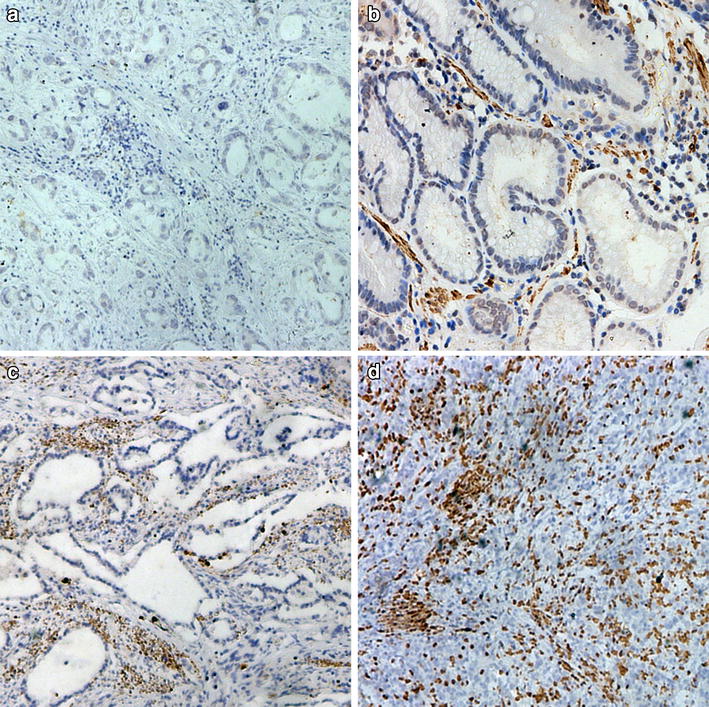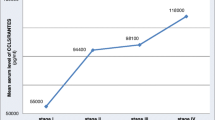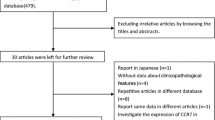Abstract
Purpose
Chemokines play multiple roles in the development and progression of many different tumors. Our cDNA array data suggested that chemokine CXCL5 was upregulated in gastric cancer. Here, we analyzed CXCL5 protein expression in gastric cancer and investigated the clinical implications of CXCL5 upregulation.
Methods
Immunostaining for CXCL5 was performed on gastric tissue microarrays of tissue specimens obtained by gastrectomy. The intensity of immunostaining in tumor tissue was considered strong when tumor tissue staining was more intense than in normal tissue; the intensity was null when staining was weaker in the tumor than in normal tissue; and the intensity was weak when staining was similar in both tissues. Serum CXCL5 levels and microvascular density in tumor tissue were measured by ELISA and monoclonal antibody to Factor VIII.
Results
Strong CXCL5 expression correlated with tumor stage. CXCL5 expression did not correlate with T stage. However, N stage positively correlated with CXCL5 expression. Serum CXCL5 levels in late stage (IIIB, IV) gastric cancer patients were higher than in patients with benign conditions. Microvascular density was higher in tumors with strong CXCL5 expression, but the correlation with CXCL5 was not linear. Multiple logistic regression analyses showed that, compared to no or weak expression, strong expression of CXCL5 was a significant risk factor for high N stage (N2, N3).
Conclusions
CXCL5 overexpression was associated with late stage gastric cancer and high N stage. These results suggest a role for CXCL5 in the progression of gastric cancer, specifically in lymph node metastasis.


Similar content being viewed by others
References
Abe S, Ogawa Y, Nagasue N, Sasaki Y, Akamizu H, Hirose S, Yukaya H, Suehiro S (1984) Early gastric cancer: results in a general hospital in Japan. World J Surg 8:308–314
Arenberg DA, Kunkel SL, Polverini PJ, Glass M, Burdick MD, Strieter RM (1996) Inhibition of interleukin-8 reduces tumorigensis of human non-small cell lung cancer. J Clin Invest 97:2792–2802
Arenberg DA, Keane MP, DiGiovine B, Kunkel SL, Morris SB, Xue YY, Burdick MD, Glass MC, Iannettoni MD, Strieter RM (1998) Epithelial-neutrophil activating peptide (ENA-78) is an important angiogenic factor in non-small cell lung cancer. J Clin Invest 102:465–472
Bacon K, Baggiolini M, Broxmeyer H, Horuk R, Lindley I, Mantovani A, Maysushima K, Murphy P, Nomiyama H, Oppenheim J, Rot A, Schall T, Tsang M, Thorpe R, Van Damme J, Wadhwa M, Yoshie O, Zlotnik A, Zoon K; IUIS/WHO Subcommittee on Chemokine Nomenclature (2002) Chemokine/chemokine receptor nomenclature. J Interferon Cytokine Res 22:1067–1068
Balkwill F (2004) Cancer and the chemokine network. Nat Rev Cancer 4:540–550
Bonacchi A, Romagnani P, Romanelli RG, Efsen E, Annunziato F, Lasagni L, Francalanci M, Serio M, Laffi G, Pinzani M, Gentilini P, Marra F (2001) Signal transduction by the chemokine receptor CXCR3: activation of Ras/ERK, Src, and phosphatidylinositol 3-kinase/Akt controls cell migration and proliferation in human vascular pericytes. J Biol Chem 276:9945–9954
Caruso RA, Bellocco R, Pagano M, Bertoloi G, Riogoli L, Inferrera C (2002) Prognostic value of intratumoral neutrophils in advanced gastric carcinoma in a high-risk area in northern Italy. Modern Pathol 15:831–837
Cenitagoya GF, Bergh CK, Klinger-Roitman J (1998) A prospective study of gastric cancer. Real 5-year survival rates and mortality rates in a country with high incidence. Dig Surg 15:317–322
Chandrasekar B, Melby PC, Sarau HM, Raveendran M, Perla RP, Marelli-Berg FM, Dulin NO, Singh IS (2003) Chemokine-Cytokine Cross-talk. The ELR+ CXC chemokine LIX (CXCL5) amplifies a proinflammatory cytokine response via a phosphatidylinositol 3-kinase-NF-nB pathway. J Biol Chem 278:4675–4686
Chandrasekar B, Bysani S, Mummidi S (2004) CXCL16 signals via Gi, phosphatidylinositol 3-kinase, Akt, InB kinase, and nuclear factor-nB and induces cell-cell adhesion and aortic smooth muscle cell proliferation. J Biol Chem 279:3188–3196
Colletti LM, Kunkel SL, Walz A, Burdick MD, Kunkel RG, Wilke CA, Strieter RM (1995) Chemokine expression during hepatic ischemia/reperfusion-induced lung injury in the rat. The role of epithelial neutrophil activating protein. J Clin Invest 95:134–141
De Larco JE, Wuertz BR, Furcht LT (2004) The potential role of neutrophils in promoting the metastatic phenotype of tumors releasing interleukin-8. Clin Cancer Res 10:4895–4900
Di Carlo E, Forni G, Lollini P, Colombo MP, Modesti A, Musiani P (2001) The intriguing role of polymorphonuclear neutrophils in antitumor reactions. Blood 97:339–345
Fidler IJ (2002) Critical determinants of metastasis. Semin Cancer Biol 12:89–96
Hundahl AS, Phillips JL, Menck HR (2000) The National Cancer Data Base report on poor survival of US gastric carcinoma patients treated with gastrectomy: fifth edition American Joint Committee on cancer staging, proximal disease, and the ‘‘different disease’’ hypothesis. Cancer 88:921–932
Hyung WJ, Noh SH, Yoo CH, Huh JH, Shin DW, Lah KH, Lee JH, Choi SH, Min JS (2002) Prognostic significance of metastatic lymph node ratio in T3 gastric cancer. World J Surg 26:323–329
Kattan MW, Karpeh MS, Mazumdar M, Brennan MF (2003) Postoperative nomogram for disease-specific survival after an R0 resection for gastric carcinoma. J Clin Oncol 21:3647–3650
Lentsch AB, Yoshidome H, Cheadle WG, Miller FN, Edwards MJ (1998) Chemokine involvement in hepatic ischemia/reperfusion injury in mice: roles for macrophage inflammatory protein-1 and Kupffer cells. Hepatology 27:507–512
Miyazaki H, Patel V, Wang H, Edmunds RK, Gutkind JS, Yeudall WA (2006) Down-regulation of CXCL5 inhibits squamous carcinogenesis. Cancer Res 66:4279–4284
Muller A, Homey B, Soto H, Ge N, Catron D, Buchanan ME, McClanahan T, Murphy E, Yuan W, Wagner SN, Barrera JL, Mohar A, Verastegui E, Zlotnik A (2001) Involvement of chemokine receptors in breast cancer metastasis. Nature 410:50–56
Nagata T, Ikeda M, Nakayama F (1983) Changing state of gastric cancer in Japan: histologic perspectives of the past 76 years. Am J Surg 145:226–233
Parkin DM, Bray FI, Devesa SS (2001) Cancer burden in the year 2000. The global picture. Eur J Cancer 37:S4–S66
Qiu Y, Zhu J, Bandi V, Atmar RL, Hattotuwa K, Guntupalli KK, Jeffery PK (2003) Biopsy neutrophilia, neutrophil chemokine and receptor gene expression in severe exacerbations of chronic obstructive pulmonary disease. Am J Resp Crit Care 168:968–975
Ridley AJ (2001) Rho GTPases and cell migration. J Cell Sci 114:2713–2722
Schraufstatter IU, Chung J, Burger M (2001) IL-8 activates endothelial cell CXCR1 and CXCR2 through Rho and Rac signaling pathways. Am J Physiol Lung Cell Mol Physiol 280:L1094–L1103
Shimoyama T, Everett SM, Dixon MF, Axon AT, Crabtree JE (1998) Chemokine mRNA expression in gastric mucosa is associated with Helicobacter pylori cagA positivity and severity of gastritis. J Clin Pathol 1998 51:765–770
Sieveking D, Mitchell HM, Day AS (2004) Gastric epithelial cell CXC chemokine secretion following Helicobacter pylori infection in vitro. J Gastroenterol Hepatol 19:982–987
Suzuki H, Mori M, Sakaguchi AA, Suzuki M, Miura S, Ishii H (1998) Enhanced levels of C-X-C chemokine, human GROalpha, in Helicobacter pylori-associated gastric disease. J Gastroenterol Hepatol 13:516–520
Venkatakrishnan G, Salgia R, Groopman JE (2000) Chemokine receptors CXCR-1/2 activate mitogen-activated protein kinase via the epidermal growth factor receptor in ovarian cancer cells. J Biol Chem 275:6868–6875
Walz A, Burgener R, Car B, Baggiolini M, Kunkel SL, Strieter RM (1991) Structure and neutrophil-activating properties of a novel inflammatory peptide (ENA-78) with homology to interleukin-8. J Exp Med 174:1355–1362
Wanebo HJ, Kennedy BJ, Chmiel J, Steele G Jr, Winchester D, Osteen R (1993) Cancer of the stomach. A patient care study by the American College of Surgeons. Ann Surg 218:583–592
Wang D, Sai J, Carter G, Sachpatzidis A, Lolis E, Richmond A (2002) PAK1 kinase is required for CXCL1-induced chemotaxis. Biochemistry 41:7100–7107
Welch DR, Scissel DJ, Howrey RP, Aeed PA (1989) Tumor-elicited polymorphonuclear cells, contrast to “normal” circulating polymorphonuclear cells, stimulate invasive and metastatic potentials of rat mammary adenocarcinoma cells. P Natl Acad Sci USA 86:5859–5863
White ES, Flaherty KR, Carskadon S, Brant A, Iannettoni MD, Yee J, Orringer MB, Arenberg DA (2003) Macrophage migration inhibitory factor and CXC chemokine expression in non-small cell lung cancer: role in angiogenesis and prognosis. Clin Cancer Res 9:853–860
Wulfing P, Kersting C, Tio J, Fischer RJ, Wulfing C, Poremba C, Diallo R, Bocker W, Kiesel L (2004) Endothelin-1-, endothelin-A-, and endothelin-B-receptor expression is correlated with vascular endothelial growth factor expression and angiogenesis in breast cancer. Clin Cancer Res 10:2393–2400
Zlotnik A, Yoshie O (2000) Chemokines: a new classification system and their role in immunity. Immunity 12:121–127
Acknowledgment
This study was supported in part by grant FG03-32-01 of the 21C Frontier Functional Human Genome Project from the Ministry of Science and Technology of Korea and by a grant from the Brain Korea 21 Project for Medical Sciences of Yonsei University College of Medicine.
Author information
Authors and Affiliations
Corresponding author
Rights and permissions
About this article
Cite this article
Park, J.Y., Park, K.H., Bang, S. et al. CXCL5 overexpression is associated with late stage gastric cancer. J Cancer Res Clin Oncol 133, 835–840 (2007). https://doi.org/10.1007/s00432-007-0225-x
Received:
Accepted:
Published:
Issue Date:
DOI: https://doi.org/10.1007/s00432-007-0225-x




